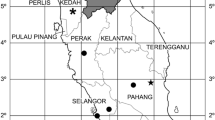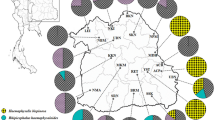Abstract
Despite their medical and veterinary importance, some tick species are so poorly studied, that their role within pathogen vector transmission cycles is difficult to assess. The tick Ixodes ventalloi is one such species, and its biology and phylogenetic status remain an issue of debate. In the present study, specimens of adult I. ventalloi (n = 65 females; n = 31 males) infesting cats in the Lipari Island (Aeolian archipelago, Sicily, southern Italy) were characterized morphologically and molecularly, the latter based on mitochondrial 16S rRNA and cytochrome c oxidase subunit 1 (cox1) genes. The genetic data and phylogenetic analyses for both mitochondrial genes suggest the existence of two distinct genogroups. The ecological and epidemiological significance of the genetic structure within the I. ventalloi endemic population remains to be determined. The results highlight the need for further analysis of this tick species, including whole mitochondrial genome sequencing and crossbreeding studies, which will be pivotal to complement features of its status as a vector of pathogens.





Similar content being viewed by others
References
Arthur DR (1963) British ticks. Butterworths, London
Arthur DR (1965) Ticks of the genus Ixodes in Africa. Athlone Press, London
Avise JC (1994) Molecular Markers, Natural History and Evolution. Chapman and Hall, New York
Bailly-Choumara H, Morel P, Rageau J (1974) Premiere contribution au catalogue des tiques du Maroc (Acari, Ixodoidea). Bull Soc Sci Nat Phys Maroc 54:71–80
Burger TD, Shao R, Barker SC (2014) Phylogenetic analysis of mitochondrial genome sequences indicates that the cattle tick, Rhipicephalus (Boophilus) microplus, contains a cryptic species. Mol Phylogenet Evol 76:241–253
Chastel C, Main AJ, Couatarmanac’h A, Le Lay G, Knudson DL, Quillien MC, Beaucournu JC (1984) Isolation of Eyach virus (Reoviridae, Colorado tick fever group) from Ixodes ricinus and I. ventalloi ticks in France. Arch Virol 82:161–171
Chilton NB, Gasser RB, Beveridge I (1995) Differences in a ribosomal DNA sequence of morphologically indistinguishable species within the Hypodontus macropi complex (Nematoda: Strongyloidea). Int J Parasitol 25:647–651
Contini C, Palmas C, Seu V, Stancampiano L, Usai F (2011) Redescription of the male of Ixodes festai Rondelli, 1926 (Ixodida: Ixodidae) on specimens from Sardinia (Italy). Parasite 18:235–240
Dantas-Torres F, Chomel BB, Otranto D (2012) Ticks and tickborne diseases: a One Health perspective. Trends Parasitol 28:437–446
Dantas-Torres F (2015) Climate change, biodiversity, ticks and tick-borne diseases: the butterfly effect. Int J Parasitol Parasites Wild 4:452–461
de la Fuente J, Estrada-Peña A, Venzal JM, Kocan KM, Sonenshine DE (2008) Overview: ticks as vectors of pathogens that cause disease in humans and animals. Front Biosci 13:6938–6946
Estrada-Peña A (2008) Climate, niche, ticks and models: what they are and how we should interpret them. Parasitol Res 103:S87–S95
Estrada-Peña A, Nava S, Petney T (2014) Description of all the stages of Ixodes inopinatus n. sp. (Acari: Ixodidae). Ticks Tick Borne Dis 5:734–743
Gilot B, Pérez C (1978) Individualisation et caractérisation de deux Ixodes actuelement confondus: I. festai Rondelli, 1926, I. ventalloi Gil Collado, 1936 (Acarina, Ixodoidea). Rev Suiss Zool 85:143–149
Gilot B, Marjolet M (1982) Contribution à l’étude du parasitisme humain par les tiques (Ixodidae et Argasidae), plus particulièrement dans le sud-est de la France. Med Mal Infect 72:340–351
Gil Collado J (1936) Acaros Ixodoideos de Cataluna y Baleares. Mus Cien Nat, Barcelona
Guglielmone AA, Robbins RG, Apanaskevich DA, Petney TN, Estrada-Peña A, Horak IG (2014). The Hard Ticks of the World (Acari: Ixodida: Ixodidae). Springer. Heidelberg
Hall TA (1999) BioEdit: a user-friendly biological sequence alignment editor and analysis program for windows 95/98/NT. Nucl Acids Symp Ser 41:95–98
Hubalek Z, Rudolf I (2012) Tick-borne viruses in Europe. Parasitol Res 111:9–36
Jameson LJ, Medlock JM (2011) Tick surveillance in Great Britain. Vector Borne Zoonotic Dis 11:403–412
Krakowetz CN, Lindsay LR, Chilton NB (2011) Genetic diversity in Ixodes scapularis (Acari: Ixodidae) from six established populations in Canada. Ticks Tick Borne Dis 2:143–450
Kimura M (1980) A simple method for estimating evolutionary rate of base substitutions through comparative studies of nucleotide sequences. J Mol Evol 16:111–120
Larkin MA, Blackshields G, Brown NP, Chenna R, McGettigan PA, McWilliam H, Valentin F, Wallace IM, Wilm A, Lopez R, Thompson JD, Gibson TJ, Higgins DG (2007) Clustal W and Clustal X version 2.0. Bioinformatics 23:2947–2948
Latrofa MS, Dantas-Torres F, Annoscia G, Cantacessi C, Otranto D (2013) Comparative analyses of mitochondrial and nuclear genetic markers for the molecular identification of Rhipicephalus spp. Infect Genet Evol 20:422–447
Manilla G (1998) Fauna d’Italia, Acari-Ixodida. Calderini (Edizioni), Bologna, Italy, pp 77–82
Mangold AJ, Bargues MD, Mas-Coma S (1998) Mitochondrial 16S rRNA sequences and phylogenetic relationships of Rhipicephalus and other tick genera among Metastriata (Acari: Ixodidae). Parasitol Res 84:478–484
Marquez FJ (2008) Spotted fever group Rickettsia in ticks from southeastern Spain natural parks. Exp Appl Acarol 45:185–194
Mori E, Sforzi A, Menchetti M, Mazza G, Lovari S, Pisanu B (2015) Ectoparasite load in the crested porcupine Hystrix cristata Linnaeus, 1758 in Central Italy. Parasitol Res 114:2223–2229
Murrell A, Campbell NJ, Barker SC (2000) Phylogenetic analyses of the rhipicephaline ticks indicate that the genus Rhipicephalus is paraphyletic. Mol Phylogenet Evol 16:1–7
Otranto D, Dantas-Torres F, Giannelli A, Latrofa MS, Cascio A, Cazzin S, Ravagnan S, Montarsi F, Zanzani SA, Manfredi MT, Capelli G (2014) Ticks infesting humans in Italy and associated pathogens. Parasit Vectors 7:328
Pennisi MG, Persichetti MF, Serrano L, Altet L, Reale S, Gulotta L, Solano-Gallego L (2015) Ticks and associated pathogens collected from cats in Sicily and Calabria (Italy). Parasit Vectors 8:512
Petney TN, Beichel E, Maiwald M, Hassler D (1996) Ixodes ventalloi: a new tick record for Germany. Appl Parasitol 37:96–98
Santos Dias JAT, Santos-Reis M (1989) A carrac¸a Ixodes ventalloi Gil Collado, 1936 como principal ectoparasitade uma populacao de doninhas (Mustela nivalis Linnaeus, 1766) em Portugal. Garcia de Orta, Serie de Zoologia 14:35–50
Santos-Silva MM, Sousa R, Santos AS, Melo P, Encarnação V, Bacellar F (2006) Ticks parasitizing wild birds in Portugal: detection of Rickettsia aeschlimannii, R. helvetica and R. massiliae. Exp Appl Acarol 39:331–338
Santos-Silva MM, Beati L, Santos AS, De Sousa R, Núncio MS, Melo P, Santos-Reis M, Fonseca C, Formosinho P, Vilela C, Bacellar F (2011) The hard-tick fauna of mainland Portugal (Acari: Ixodidae): an update on geographical distribution and known associations with hosts and pathogens. Exp Appl Acarol 55:85–121
Tamura K, Battistuzzi FU, Billing-Ross P, Murillo O, Filipski A, Kumar S (2012) Estimating divergence times in large molecular phylogenies. PNAS 109:19333–19338
Tamura K, Stecher G, Peterson D, Filipski A, Kumar S (2013) MEGA6: Molecular Evolutionary Genetics Analysis version 6.0. Mol Bio Evol 30:2725–2729
Acknowledgments
The authors would like to thank Dr. Viviana Domenica Tarallo (University of Bari) for the I. ventalloi drawing in Fig. 2.
Author information
Authors and Affiliations
Corresponding author
Ethics declarations
Conflict of interest
The authors declare that they have no conflict of interest.
Rights and permissions
About this article
Cite this article
Latrofa, M.S., Giannelli, A., Persichetti, M.F. et al. Ixodes ventalloi: morphological and molecular support for species integrity. Parasitol Res 116, 251–258 (2017). https://doi.org/10.1007/s00436-016-5286-9
Received:
Accepted:
Published:
Issue Date:
DOI: https://doi.org/10.1007/s00436-016-5286-9




